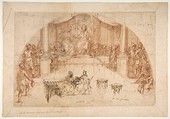The Coronation of Esther
Carlo Urbino Italian
Not on view
This detailed sketch was formerly ascribed to Paolo Veronese (note on the mount), but when it was acquired by the Metropolitan Museum in 1984, Lawrence Turčić proposed that it might instead be the work of Carlo Urbino (March 1984), a relatively little known painter from Crema whose drawings are somewhat similar in style to those of Bernardino Campi. The attribution to Urbino was subsequently confirmed by Giulio Bora, who connected the sheet with a fresco in the church of Santa Maria di Campagna at Pallanza, on Lago Maggiore. According to Bora, the interior of the charch was richly decorated about 1576-77 by Urbino in collaboration with the Milanese painter Aurelio Luini. Luini was responsible for roughly half of the large ‘Assumption of the Virgin’ that occupies the entire apse of the church, as well as for the figures of Saint Mark and Saint Luke in the pedentives beneath the dome and the ‘Death of the Virgin on the apsidal arch.
Urbino apparently painted the other half of the ‘Assumption’, the figures of Saint John the Evangelist ans Saint Matthew in the pedentives, and the ‘Coronation of Esther’ in the presbytery, where it is paired with Luini’s ‘Dearth of the Virgin.’ He is also credited with the design – if not the actual execution – of much of the rest of the decoration of the building. The present sketch is a compositional study with minor differences for the fresco of the Coronation of Ester, a subject that prefigures the elevation of the Virgin Mary to her role as Queen of Haeven. The autograph inscription in pen and ink "13. giornate" (13 days) presumably refers to the number of days that would be required to execute the fresco.
Due to rights restrictions, this image cannot be enlarged, viewed at full screen, or downloaded.
This artwork is meant to be viewed from right to left. Scroll left to view more.






